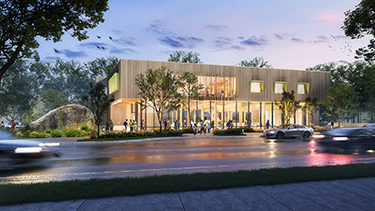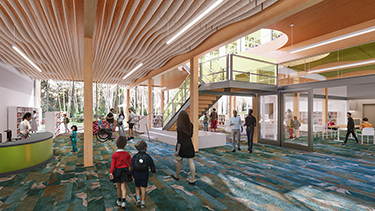|
Subscribe / Renew |
|
|
Contact Us |
|
| ► Subscribe to our Free Weekly Newsletter | |
| home | Welcome, sign in or click here to subscribe. | login |
Architecture & Engineering
| |
February 12, 2024
Mass timber library set for Lake Stevens
A/E Editor
The city of Lake Stevens is set to get a new library, built sustainably with mass timber, that includes indoor and outdoor reading and learning areas and a welcoming public plaza.
Sno-Isle Libraries is developing the project, which it plans to build on a 4.5-acre parcel at 114 99th Ave. N.E. in Lake Steven's Chapel Hill neighborhood.
A land use application was submitted to the city for the project last month and a building permit application should follow this month.
The project scope comprises a 15,000-square-foot, two-story public library and site work including surface parking, the plaza, the outdoor learning area, wetland mitigation, and street frontage improvements.
Seattle-based BuildingWork is the project architect and is currently finalizing designs.
Sno-Isle purchased the land for the new library in 2016. It was formerly the site of a single-family home that was demolished, and the site cleared for redevelopment, by Northend Excavating last spring.
The library is funded in part by $3.1 million in state grants secured by Sno-Isle Libraries. The funds have matching requirements, which the library district is committed to securing or providing.
Depending on the permitting process, the project should go out to bid this fall with construction slated to begin in early 2025.
BuildingWork says the new library is “designed to respond with sensitivity to its natural environment and to create a welcoming and inspiring place for people to gather, study, and learn.”
The project site is unique for several reasons. Tantamount is a duo of pink crystal and granite erratic boulders that were carried to the site by a glacier thousands of years ago. The back side of the parcel is also bordered by wetlands and is forested.
Matt Aalfs, founding principal at BuildingWork, told the DJC that these natural features were “the first design elements for the project” and that the library has been conceived in response to them. The larger of the two boulders will take pride of place at the library's main entry. The wetlands will be protected and enhanced by restoring buffer space, using native plants to repopulate the property. That new wetland buffer will take up around 40% of the site.
Preserving and highlighting these natural features significantly reduced the amount of space for new construction and drove the decision to build a two-story library, which is fairly uncommon for modern suburban libraries. Aalfs said he believes this decision will give the building a “strong and unique civic presence.”
The library will be built with a sustainable mass timber structure of cross-laminated timber panels supported by glulam framing. The structure will be exposed inside to create a warm and appealing environment that also responds to the nearby forest.
“We want to center the mass timber as an aesthetic element to encourage occupants to think about the environment and our use of natural resources,” Aalfs shared.
Inside the library will be early learning space, community meeting rooms, quiet areas for independent study, dedicated child and teen areas, computing and technology areas, co-working space, restrooms, and space for larger events and programs.
Outside will be additional learning spaces and the public plaza.
Aalfs said the lower level of the library is conceived as an “extroverted” and active place framed by floor-to-ceiling windows. This level will house an open entrance area, large community meeting room and an expansive children's area and early learning space that will include a low-stimulation zone for neurodivergent children.
The upper level, on the other hand, will have a more “introverted” character reminiscent of a treehouse, and will include private work areas such as smaller study rooms and a computer lab. This is also where most of the books will be.
The outside learning space will also include a tree-like structure, designed by project landscape architect Swift Co., to be used for storytelling and learning opportunities.
The project is targeting LEED Gold certification.
Lake Stevens Library has served the community for over 75 years. Since May 2021, it has operated out of a temporary location in a former police station at 2211 Grade Road.
Sno-Isle and the city of Lake Stevens previously considered co-developing the project site, and some surrounding city-owned parcels, with a new civic center including new library space. That project was scrapped in spring 2022.
“This is a really exciting project for us, the client, and for the community of Lake Stevens that has been trying to get a new library built for many years,” Aalfs said.
The project team also includes: KPFF, civil and structural engineer; Greenbusch, mechanical engineer; TFWB, electrical engineer; Blanca, lighting designer; RDH, envelope consultant; SSA, acoustic consultant; ArchEcology, LEED consultant; ABI, specifications consultant; Hamasaki Consulting Engineers, commissioning agent; and Shannon & Wilson, geotechnical engineer and wetlands consultant.
Emma Hinchliffe can be
reached by email or by phone
at (206) 622-8272.




